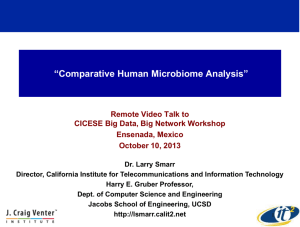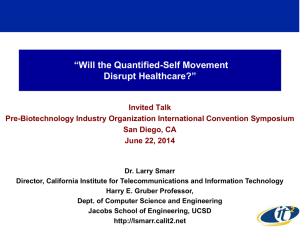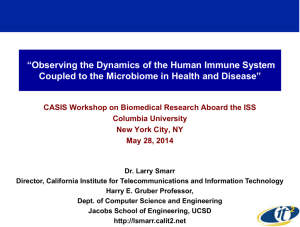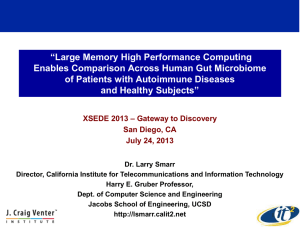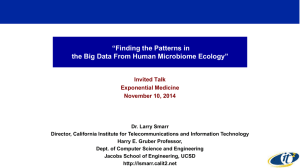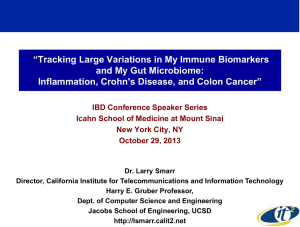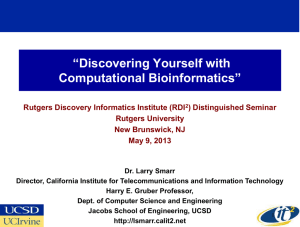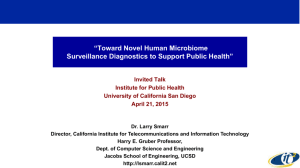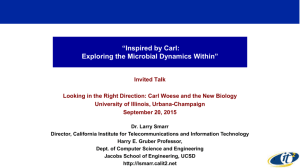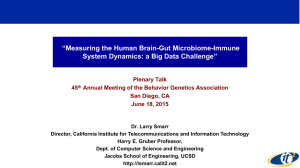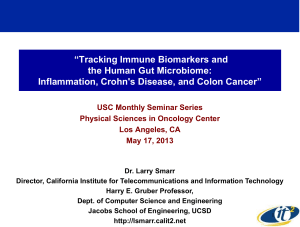PPT - Larry Smarr - California Institute for Telecommunications and
advertisement
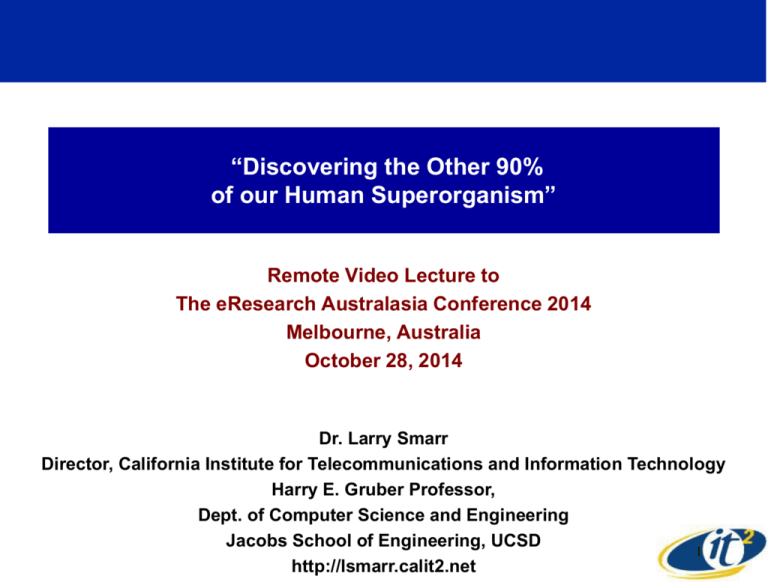
“Discovering the Other 90% of our Human Superorganism” Remote Video Lecture to The eResearch Australasia Conference 2014 Melbourne, Australia October 28, 2014 Dr. Larry Smarr Director, California Institute for Telecommunications and Information Technology Harry E. Gruber Professor, Dept. of Computer Science and Engineering Jacobs School of Engineering, UCSD 1 http://lsmarr.calit2.net Abstract The human body is host to 100 trillion microorganisms, ten times the number of cells in the human body, and these microbes contain 100 times the number of DNA genes that our human DNA does. The microbial component of our “superorganism” is comprised of hundreds of species with immense biodiversity. Thanks to the National Institutes of Health’s Human Microbiome Program researchers have been discovering the states of the human microbiome in health and disease. To put a more personal face on the “patient of the future,” I have been collecting massive amounts of data from my own body over the last five years, which reveals detailed examples of the episodic evolution of this coupled immune-microbial system. An elaborate software pipeline, running on high performance computers, reveals the details of the microbial ecology and its genetic components. As a result of discovering the "missing" 90% of our bodies, we can look forward to revolutionary changes in medical practice over the next decade. A Decade of eResearch Partnering With Australia Phil Scanlan, AALD University of Melbourne J David Abramson, Monash University u Chris Hancock, aarnet Bernard Pailthorpe, UQ From One to a Billion Data Points Defining Me: The Exponential Rise in Body Data in Just One Decade Genome Billion:Microbial My Full DNA, MRI/CT Images Improving Body SNPs Million: My DNA SNPs, Zeo, FitBit Discovering Disease Blood Variables One: My Weight Weight Hundred: My Blood Variables Visualizing Time Series of 150 LS Blood and Stool Variables, Each Over 5-10 Years Calit2 64 megapixel VROOM Only One of My Blood Measurements Was Far Out of Range--Indicating Chronic Inflammation 27x Upper Limit Episodic Peaks in Inflammation Followed by Spontaneous Drops Normal Range <1 mg/L Normal Complex Reactive Protein (CRP) is a Blood Biomarker for Detecting Presence of Inflammation Adding Stool Tests Revealed Oscillatory Behavior in an Immune Variable Typical Lactoferrin Value for Active IBD 124x Upper Limit Normal Range <7.3 µg/mL Lactoferrin is a Protein Shed from Neutrophils An Antibacterial that Sequesters Iron Confirming the IBD (Crohn’s) Hypothesis: Finding the “Smoking Gun” with MRI Imaging Liver Transverse Colon Small Intestine I Obtained the MRI Slices From UCSD Medical Services and Converted to Interactive 3D Working With Calit2 Staff & DeskVOX Software Descending Colon MRI Jan 2012 Cross Section Diseased Sigmoid Colon Major Kink Sigmoid Colon Threading Iliac Arteries Why Did I Have an Autoimmune Disease like IBD? Despite decades of research, the etiology of Crohn's disease remains unknown. Its pathogenesis may involve a complex interplay between host genetics, immune dysfunction, and microbial or environmental factors. --The Role of Microbes in Crohn's Disease So I Set Out to Quantify All Three! Paul B. Eckburg & David A. Relman Clin Infect Dis. 44:256-262 (2007) The Cost of Sequencing a Human Genome Has Fallen Over 10,000x in the Last Ten Years This Has Enabled Sequencing of Both Human and Microbial Genomes Single Nucleotide Polymorphisms (SNPs) Make Up About 90% of All Human Genetic Variation Person A SNPs Occur Every 100 to 300 Bases Along Human DNA Person B www.23andme.com Tracks One Million SNPs I Found I Had One of the Earliest Known SNPs Associated with Crohn’s Disease From www.23andme.com ATG16L1 IRGM NOD2 Polymorphism in Interleukin-23 Receptor Gene — 80% Higher Risk of Pro-inflammatory Immune Response rs1004819 SNPs Associated with CD 23andme is Collecting 10,000 IBD Patient’s SNPs to Map Into the 163 Known SNPs Associated with IBD Inclusion of the Microbiome Will Radically Change Medicine and Wellness Your Body Has 10 Times As Many Microbe Cells As Human Cells 99% of Your DNA Genes Are in Microbe Cells Not Human Cells I Will Focus on the Human Gut Microbiome, Which Contains Hundreds of Microbial Species Intense Scientific Research is Underway on Understanding the Human Microbiome June 8, 2012 June 14, 2012 August 18, 2012 When We Think About Biological Diversity We Typically Think of the Wide Range of Animals But All These Animals Are in One SubPhylum Vertebrata of the Chordata Phylum All images from Wikimedia Commons. Photos are public domain or by Trisha Shears & Richard Bartz Think of These Phyla of Animals When You Consider the Biodiversity of Microbes Inside You Phylum Chordata Phylum Cnidaria Phylum Echinodermata Phylum Annelida Phylum Mollusca Phylum Arthropoda All images from WikiMedia Commons. Photos are public domain or by Dan Hershman, Michael Linnenbach, Manuae, B_cool The Evolutionary Distance Between Your Gut Microbes Is Much Greater Than Between All Animals Last Slide Green Circles Are Human Gut Microbes Evolutionary Distance Derived from Comparative Sequencing of 16S or 18S Ribosomal RNA Source: Carl Woese, et al A Year of Sequencing a Healthy Gut Microbiome Daily Remarkable Stability with Abrupt Changes Days Genome Biology (2014) David, et al. To Map Out the Dynamics of My Microbiome Ecology I Partnered with the J. Craig Venter Institute • JCVI Did Metagenomic Sequencing on Seven of My Stool Samples Over 1.5 Years • Sequencing on Illumina HiSeq 2000 – Generates 100bp Reads – Run Takes ~14 Days – My 7 Samples Produced Illumina HiSeq 2000 at JCVI – >200Gbp of Data • JCVI Lab Manager, Genomic Medicine – Manolito Torralba • IRB PI Karen Nelson – President JCVI Manolito Torralba, JCVI Karen Nelson, JCVI We Expanded Our Healthy Cohort to All Gut Microbiomes from NIH HMP For Comparative Analysis Each Sample Has 100-200 Million Illumina Short Reads (100 bases) “Healthy” Individuals IBD Patients 250 Subjects 1 Point in Time 2 Ulcerative Colitis Patients, 6 Points in Time Larry Smarr (Colonic Crohn’s) 7 Points in Time 5 Ileal Crohn’s Patients, 3 Points in Time Total of 27 Billion Reads Or 2.7 Trillion Bases Source: Jerry Sheehan, Calit2 Weizhong Li, Sitao Wu, CRBS, UCSD We Created a Reference Database Of Known Gut Genomes • NCBI April 2013 – – – – 2471 Complete + 5543 Draft Bacteria & Archaea Genomes 2399 Complete Virus Genomes 26 Complete Fungi Genomes 309 HMP Eukaryote Reference Genomes • Total 10,741 genomes, ~30 GB of sequences Now to Align Our 27 Billion Reads Against the Reference Database Source: Weizhong Li, Sitao Wu, CRBS, UCSD Computational NextGen Sequencing Pipeline: From “Big Equations” to “Big Data” Computing PI: (Weizhong Li, CRBS, UCSD): NIH R01HG005978 (2010-2013, $1.1M) We Used SDSC’s Gordon Data-Intensive Supercomputer to Analyze a Wide Range of Gut Microbiomes Source: Weizhong Li, Sitao Wu, CRBS, UCSD Our Team Used 25 CPU-Years To Compute the Comparative Gut Microbiome of My Time Samples and Our Healthy and IBD Controls Starting With the 5 Billion Illumina Reads Received from JCVI Enabled by a Grant of Time on Gordon from SDSC Director Mike Norman We Used Dell’s HPC Cloud to Analyze All of Our Human Gut Microbiomes • Dell’s Sanger Cluster – 32 Nodes, 512 Cores – 48GB RAM per Node • We Processed the Taxonomic Relative Abundance – Used ~35,000 Core-Hours on Dell’s Sanger • Produced Relative Abundance of ~10,000 Bacteria, Archaea, Viruses in ~300 People – ~3Million Spreadsheet Cells • New System: R Bio-Gen System – 48 Nodes, 768 Cores – 128 GB RAM per Node Source: Weizhong Li, UCSD We Found Major State Shifts in Microbial Ecology Phyla Between Healthy and Two Forms of IBD Average HE Most Common Microbial Phyla Average Ulcerative Colitis Explosion of Proteobacteria Average LS Hybrid of UC and CD High Level of Archaea Average Crohn’s Disease Collapse of Bacteroidetes Explosion of Actinobacteria Using Scalable Visualization Allows Comparison of the Relative Abundance of 200 Microbe Species Comparing 3 LS Time Snapshots (Left) with Healthy, Crohn’s, UC (Right Top to Bottom) Calit2 VROOM-FuturePatient Expedition Using Microbiome Profiles to Survey 155 Subjects for Unhealthy Candidates Using Principal Component Analysis To Stratify Disease States From Healthy States From www.23andme.com Mutation in Interleukin-23 Receptor Gene—80% Higher Risk of Pro-inflammatory Immune Response SNPs Associated with CD 2009 Dell Analytics Separates The 4 Patient Types in Our Data Using Microbiome Species Data Source: Thomas Hill, Ph.D. Executive Director Analytics Dell | Information Management Group, Dell Software Connecting Diet, Gut Microbes, and Disease Absence of Ruminococcus bromii May Impair Fermentation in IBD Patients “This argues strongly that R. bromii has a pivotal role in fermentation of [resistant starch] RS3 in the human large intestine, and that variation in the occurrence of this species and its close relatives may be a primary cause of variable energy recovery from this important component of the diet.” Supports Research on Importance of Resistant Starch for Gut Health by Drs. David Topping and Mark Morrison in Australia Time Series Reveals Autoimmune Dynamics of Gut Microbiome by Phyla Therapy Six Metagenomic Time Samples Over 16 Months Inexpensive Consumer 16S Time Series of Microbiome Allows Similar Analysis Through Ubiome Data source: LS (Yellow Lines Stool Samples); Sequencing and Analysis Ubiome There is a Huge New Field of Products Coming Which Enable You to “Garden” Your Microbiome “I would like to lose the language of warfare,” said Julie Segre, a senior investigator at the National Human Genome Research Institute. ”It does a disservice to all the bacteria that have co-evolved with us and are maintaining the health of our bodies.” Will Medical Foods Provide New Tools for Altering Gut Microbiome? Faecal Microbiota Transplantation (FMT) Therapy Has Been Pioneered in Australia Controversial, but very promising. More experiments needed on a variety of disease states. Picture: Danielle Butters Professor Tom Borody, founder and current medical director of the Center for Digestive Diseases (CDD) in Sydney, Australia "I think we're on the edge of something extraordinary. The attention has switched entirely to the large bowel bacterial population which we now know is absolutely critical to human health," --Dr. David Topping, Chief Research Scientist at CSIRO Animal, Food and Health Sciences in Adelaide, South Australia 18 Mar 2014 Early Adopting MDs Are Creating Partnerships with Their Quantified Patients • “The 100 participants will be guided on this 9-month journey by a coach and when necessary, be referred to their own health care practitioners.” • The data sets that will be evaluated include: – – – – – Self-Tracking Devices Medical History, Traits, Lifestyle Blood, Urine, Saliva Gut Microbiome Whole Genome Sequencing Will Grow to 1000, then 10,000 https://pioneer100.systemsbiology.net/ UC San Diego Is Carrying Out a Major Clinical Study of IBD Using These Techniques Goal: Understand The Coupled Human Immune-Microbiome Dynamics In the Presence of Human Genetic Predispositions Already 100 Enrolled, Goal is 1500 Drs. William J. Sandborn, John Chang, & Brigid Boland UCSD School of Medicine, Division of Gastroenterology Thanks to Our Great Team! UCSD Metagenomics Team JCVI Team Weizhong Li Sitao Wu Karen Nelson Shibu Yooseph Manolito Torralba SDSC Team Calit2@UCSD Future Patient Team Jerry Sheehan Tom DeFanti Kevin Patrick Jurgen Schulze Andrew Prudhomme Philip Weber Fred Raab Joe Keefe Ernesto Ramirez Michael Norman Mahidhar Tatineni Robert Sinkovits UCSD Health Sciences Team William J. Sandborn Elisabeth Evans John Chang Brigid Boland David Brenner
